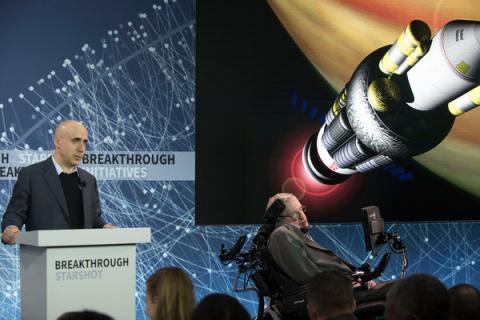Stephen Hawking and Yuri Milner want to Build an Interstellar Starship
The technology behind the billionaire’s ambitious proposal—of which prototypes were revealed today—includes a “Starchip,” a gram scale wafer carrying cameras, photon thrusters, power supply, navigation, and communication equipment. Propelling that miniature science laboratory is a “Lightsail,” a meter-sized sail that’s only a few hundred atoms thick and weighs a couple of grams. The light sail will be launched away from the Earth by a phased array of lasers, which Milner envisions carrying a combined power of over 100 Gigawatts, similar to the power needed to lift the Space Shuttle off Earth.
By directing that much energy at an object weighing just a few grams, we can theoretically accelerate said object up to 100,000,000 miles per hour—a thousand times faster than the fastest spacecraft today. The idea is to launch a small fleet of craft toward Alpha Centauri, allowing us to perform many, many New Horizon-like flybys of our nearest neighbor’s potentially habitable real-estate.
If this all sounds like the insanely ambitious fantasy of a starstruck billionaire, that’s because it is. But according to Milner, it’s also doable with technology not too far off. He believes we can be deploying our first nanocraft within a generation. “The Breakthrough concept is based on technology either already available or likely to be available in the near future,” Milner said. “But as with any moonshot, there are major hurdles to be solved.”
Indeed, the hurdles range from how to create the laser array capable of accelerating a small payload off Earth to how to transmit data back to us over interstellar distances. These will be huge accomplishments, with reverberations throughout many fields of science and technology. That’s why Milner and his crew of would-be spacefarers are soliciting contributions from the international scientific community and the public alike. Breakthrough Starshot, Milner said, will be based entirely on work in the public domain.
“It’s an ambitious project, but we don’t see any showstoppers or deal breakers based on fundamental principles,” Avi Loeb, chair of the Harvard Center for Astrophysics and a co-sponsor of Breakthrough Starshot, said at the press briefing.
Loeb added that even before we reach Alpha Centauri, a fleet of nanocraft packed with advanced scientific equipment could collect troves of information within our Solar System. They could, for instance, fly through the south pole geyser of Saturn’s moon Enceladus, and scan the alien ocean water for signs of life—something astrobiologists have been itching to do for years.
“Here, at One World Observatory, we are launching a collaborative planetary endeavor,” Milner continued. “Only by challenging ourselves can we find out if we, like the pioneers before us, have the ability and ambition to succeed.”
Maddie Stone

